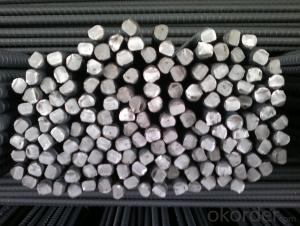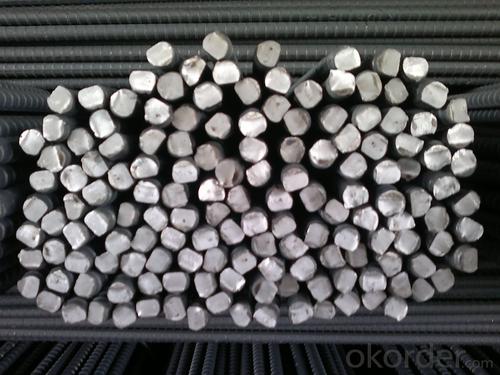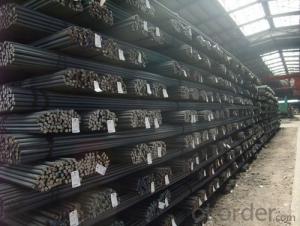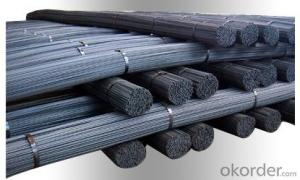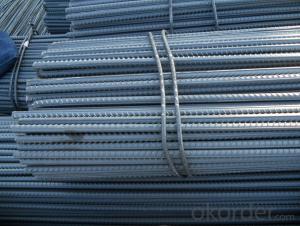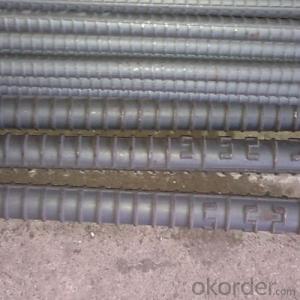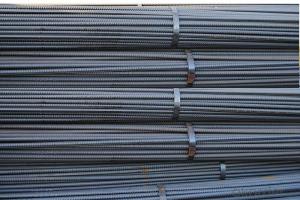Deformed Steel Bars All Size Steel Rebars with high quality
- Loading Port:
- Tianjin
- Payment Terms:
- TT or LC
- Min Order Qty:
- 50 m.t
- Supply Capability:
- 20000 m.t/month
OKorder Service Pledge
OKorder Financial Service
You Might Also Like
Product Description:
OKorder is offering Deformed Steel Bars All Size Steel Rebars with high qualityBuilding Material China Manufacturer at great prices with worldwide shipping. Our supplier is a world-class manufacturer of steel, with our products utilized the world over. OKorder annually supplies products to European, North American and Asian markets. We provide quotations within 24 hours of receiving an inquiry and guarantee competitive prices.
Product Applications:
Deformed Steel Bars All Size Steel Rebars with high quality,Building Material China Manufacturer are ideal for structural applications and are widely used in the construction of buildings and bridges, and the manufacturing, petrochemical, and transportation industries.
Product Advantages:
OKorder's Deformed Steel Bars All Size Steel Rebars with high quality,Building Material China Manufacturer are durable, strong, and resist corrosion.
Main Product Features:
· Premium quality
· Prompt delivery & seaworthy packing (30 days after receiving deposit)
· Mill test certification
· Professional Service
· Competitive pricing
Product Specifications:
commodity:deformed steel bars
2.grade:ASTM A615 HRB335 HRB400 HRB500 BS4449 grade460
3.size:6#-32#
4.length:6m 9m 12m
We henglong can offer high quality deformed steel bar
grade:ASTM A615 BS4449 GRADE460 HRB335 HRB400 HRB500
size:6# to 32#
length:6M 9M 12M
Chemistry % | |||||||||||||
Designation | Chief component | Impurities maxmium | |||||||||||
Ta | Nb | Fe | Si | Ni | W | Mo | Ti | Nb | O | C | H | N | |
Ta1 | Remainder | 0.004 | 0.003 | 0.002 | 0.004 | 0.004 | 0.002 | 0.03 | 0.015 | 0.004 | 0.0015 | 0.002 | |
Ta2 | Remainder | 0.01 | 0.01 | 0.005 | 0.02 | 0.02 | 0.005 | 0.08 | 0.02 | 0.01 | 0.0015 | 0.01 | |
Permissible variations in diameter for rods
Diameter, inch (mm) | Tolerance, +/-inch (mm) |
0.125~0.187 excl (3.175~4.750) | 0.003 (0.076) |
0.187~0.375 excl (4.750~9.525) | 0.004 (0.102) |
0.375~0.500 excl (9.525~12.70) | 0.005 (0.127) |
0.500~0.625 excl (12.70~15.88) | 0.007 (0.178) |
0.625~0.750 excl (15.88~19.05) | 0.008 (0.203) |
0.750~1.000 excl (19.05~25.40) | 0.010 (0.254) |
1.000~1.500 excl (25.40~38.10) | 0.015 (0.381) |
1.500~2.000 excl (38.10~50.80) | 0.020 (0.508) |
2.000~2.500 excl (50.80~63.50) | 0.030 (0.762) |
FAQ:
Q1: How do we guarantee the quality of our products?
A1: We have established an advanced quality management system which conducts strict quality tests at every step, from raw materials to the final product. At the same time, we provide extensive follow-up service assurances as required.
Q2: How soon can we receive the product after purchase?
A2: Within three days of placing an order, we will begin production. The specific shipping date is dependent upon international and government factors, but is typically 7 to 10 workdays.
Q3: What makes stainless steel stainless?
A3: Stainless steel must contain at least 10.5 % chromium. It is this element that reacts with the oxygen in the air to form a complex chrome-oxide surface layer that is invisible but strong enough to prevent further oxygen from "staining" (rusting) the surface. Higher levels of chromium and the addition of other alloying elements such as nickel and molybdenum enhance this surface layer and improve the corrosion resistance of the stainless material.
Images:
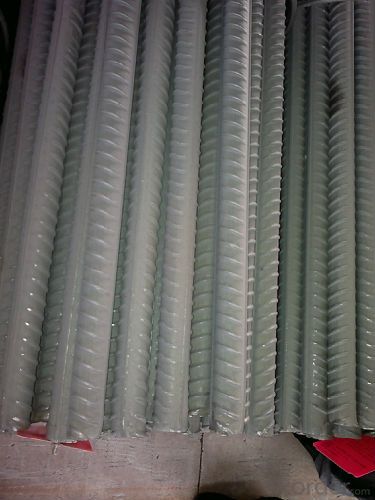
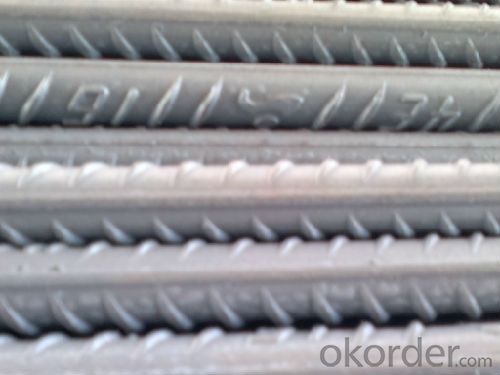
- Q: What is the national standard of thread steel No. 8?
- Rebar national standard: transverse rib nominal spacing shall not be greater than 0.7 times the nominal diameter of steel, the cross rib side and the steel surface of the angle of alpha may not be less than 45 degrees. When the steel nominal diameter less than 12mm, the relative rib area should not be less than 0.055, the nominal diameter of 14mm and 16mm, the relative rib area should not be less than 0.060, the nominal diameter is more than 16mm, the relative rib area should not be less than 0.065. Therefore, the nominal diameter of rebar No. 8 national standard steel bar relative rib area shall not be less than 0.055mm
- Q: Can steel rebars be used in the construction of shopping centers?
- Yes, steel rebars can be used in the construction of shopping centers. Steel rebars, also known as reinforcing bars, are commonly used in the construction industry to reinforce concrete structures. Shopping centers often require strong, durable, and long-lasting infrastructure, and steel rebars provide the necessary strength and reinforcement to support the weight and load of the building. They help to prevent cracks, increase structural stability, and enhance the overall durability of the construction. Additionally, steel rebars can be easily shaped and cut to fit the specific design requirements of a shopping center, making them a versatile and practical choice for construction projects.
- Q: What are the common mistakes to avoid while using steel rebars?
- When using steel rebars, there are several common mistakes that should be avoided to ensure the structural integrity and safety of the construction project. Some of these mistakes include: 1. Insufficient cover: Failing to provide enough concrete cover over the rebars can lead to corrosion and reduced strength. It is important to follow the design specifications and ensure the required cover is maintained throughout the construction process. 2. Improper placement: Incorrectly placing the rebars can result in weak areas within the structure. It is crucial to follow the approved drawings and ensure proper spacing, alignment, and lap lengths are maintained. 3. Inadequate anchoring: Insufficient anchoring of the rebars can lead to inadequate load transfer and structural failure. It is essential to properly anchor the rebars by providing adequate hooks or bends at the ends and using appropriate tie wire or mechanical connectors. 4. Poor welding practices: If welding is required to connect rebars, it is essential to follow proper welding procedures and ensure high-quality welds. Inadequate or improper welding can weaken the rebars and compromise the structural strength. 5. Neglecting corrosion protection: Steel rebars are susceptible to corrosion, especially in humid or marine environments. Neglecting to provide proper corrosion protection, such as epoxy coating or corrosion inhibitors, can result in premature deterioration and reduced structural performance. 6. Overlapping rebars incorrectly: Overlapping rebars is necessary to ensure the transfer of forces between adjacent sections. However, overlapping them incorrectly by either insufficient length or improper alignment can compromise the structural integrity. 7. Lack of inspection and quality control: Failing to conduct regular inspections and quality control checks during the construction process can lead to unnoticed mistakes or deviations from the design. It is crucial to have qualified personnel inspect the rebars and ensure compliance with the specifications and industry standards. By avoiding these common mistakes and adhering to best practices, the structural integrity and safety of the construction project can be upheld. It is essential to consult with structural engineers, follow approved drawings and specifications, and ensure proper installation and quality control to prevent any potential issues.
- Q: Grade 1, grade three, grade two, steel, wire rod, round bar
- Steel is commonly known as hot rolled ribbed bar, belonging to the small steel steel, mainly used for steel reinforced concrete structure frame. In use, some mechanical strength, bending deformation property and welding performance are required. The raw steel billet for the production of threaded steel is carbon structural steel or low alloy structural steel which is treated by calm melting, and the finished steel bar is delivered in hot rolling forming, normalizing or hot rolling state.
- Q: Can steel rebars be used in railway construction?
- Yes, steel rebars can be used in railway construction. Steel rebars are commonly used in reinforced concrete structures, including railway infrastructure such as bridges, tunnels, and platforms. They provide strength, durability, and support to the railway infrastructure, ensuring its stability and longevity.
- Q: How are steel rebars used in tunnel construction?
- Steel rebars are used in tunnel construction to provide reinforcement and strength to the concrete structures. These rebars are embedded within the concrete walls, floors, and ceilings of the tunnel to enhance its structural integrity and prevent cracks or collapses.
- Q: What is the process of threading steel rebars?
- Threading steel rebars involves creating threads on the ends of the rebars to allow for easy and secure connection with other rebars or structural elements. This is typically done using a machine called a rebar threading machine. The first step is to cut the rebars to the desired length and clean the ends to remove any dirt, rust, or debris that could interfere with the threading process. This ensures a smooth and accurate threading operation. Once the rebars are prepared, the rebar threading machine is set up. It consists of a spindle that rotates at a high speed, along with a threading die positioned on the spindle. The threading die has grooves and ridges designed to cut threads into the rebars. To thread a rebar, one end is inserted into the threading machine while the other end is held firmly in place. The machine is then started, and the spindle rotates to cut into the rebar's surface, creating threads by removing small amounts of material. The machine is operated until the desired length of threads is achieved, which can vary depending on project requirements and the type of connection being made. It is crucial to ensure accurate and consistent cutting of the threads to maintain the structural integrity of the rebar connections. After the threading process is complete, the threaded rebars are inspected to ensure clean and defect-free threads that meet the required standards. They are then ready for use in construction projects, where they can be connected to other rebars or structural elements using various methods such as couplers or nuts. In conclusion, threading steel rebars involves cutting and cleaning the rebars, setting up a rebar threading machine, inserting the rebars, and using a threading die to create threads. This process ensures easy and secure connection of rebars in construction projects, providing strength and stability to the structures they are used in.
- Q: How long do steel rebars last in structures?
- Steel rebars can last for several decades, typically around 50 to 100 years, when used in structures. However, their lifespan can be affected by various factors such as the quality of the rebar, environmental conditions, maintenance practices, and exposure to corrosive agents. Regular inspections and proper maintenance can significantly extend the lifespan of steel rebars in structures.
- Q: How are steel rebars anchored into concrete?
- To securely fix steel rebars into concrete, various methods are employed. One commonly used approach involves the utilization of mechanical anchors, such as anchor bolts or anchor plates. These mechanical anchors are introduced into the concrete prior to its setting, and subsequently, the rebars are fastened to them using nuts, washers, or other fastening devices. This technique establishes a reliable and robust connection between the rebars and the concrete. Another method employed in anchoring rebars into concrete involves the use of epoxy or adhesive anchors. In this particular approach, a specialized epoxy or adhesive substance is applied to the rebars, which are then inserted into pre-drilled holes in the concrete. The epoxy or adhesive subsequently solidifies, forming a powerful bond that securely anchors the rebars to the concrete. Additionally, mechanical couplers can also be employed to anchor rebars into concrete. These couplers serve the purpose of connecting two rebars together, creating a continuous reinforcement. The installation process involves threading the rebars into the coupler and subsequently tightening them together using wrenches or other tools. This method ensures a seamless connection between the rebars, eliminating the need for overlapping or lapping of rebars and saving valuable time and materials. In conclusion, the anchoring of steel rebars into concrete is a vital step in the construction process, as it guarantees that the rebars provide the essential reinforcement and structural integrity to the concrete structure. The selection of the appropriate anchoring method is contingent upon several factors, including project-specific requirements, desired load capacity, and design specifications.
- Q: How do steel rebars help in load distribution within a structure?
- Steel rebars, also referred to as reinforcing bars, are essential for the distribution of loads within a structure. They are extensively utilized in concrete structures, like buildings, bridges, and highways, to enhance their strength and durability. The main objective of steel rebars is to provide tensile strength to the concrete. While concrete is highly capable of withstanding compression, it is relatively frail when it comes to tension. Any structure exposed to loads, whether from the weight of the building itself or external forces, will encounter both compression and tension forces. By incorporating steel rebars into the concrete, they act as reinforcements and resist tensile forces. When an external load is applied to the structure, the rebars bear a significant portion of the generated tension forces. This prevents the concrete from cracking or failing under the applied load. Furthermore, steel rebars aid in the distribution of the load throughout the structure. When a load is imposed on a structure, it generates stress that is spread across the various components. The presence of rebars enables a more uniform distribution of these stresses, reducing the concentration of forces in specific areas. This prevents localized failures and ensures that the load is evenly dispersed across the structure, thereby improving its overall strength and stability. Another crucial aspect of steel rebars is their capacity to bond with concrete. The rough surface of the rebars prevents them from slipping or separating from the concrete, ensuring a robust bond between the two materials. This bond further enhances the distribution of loads by enabling the rebars to effectively transfer the tensile forces to the surrounding concrete. In conclusion, steel rebars play a critical role in the distribution of loads within a structure. They furnish the necessary tensile strength to withstand tension forces, distribute the load evenly across the structure, and bond with the concrete, guaranteeing a sturdy and stable construction. Without steel rebars, concrete structures would be considerably weaker and more prone to cracking or failure under load.
Send your message to us
Deformed Steel Bars All Size Steel Rebars with high quality
- Loading Port:
- Tianjin
- Payment Terms:
- TT or LC
- Min Order Qty:
- 50 m.t
- Supply Capability:
- 20000 m.t/month
OKorder Service Pledge
OKorder Financial Service
Similar products
Hot products
Hot Searches
Related keywords
